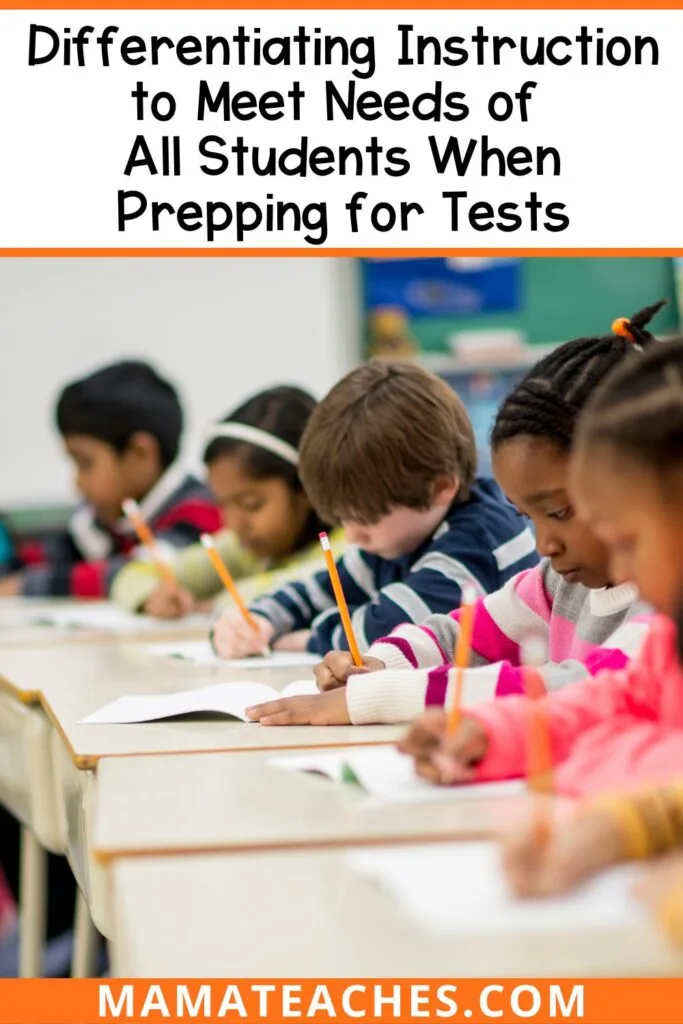Test prep is not one size fits all. Your students each have different needs. Learn all about differentiating instruction for test prep.

Why You Should Differentiate Test Prep
Students are all different, and they need to prepare for tests in different ways. This can be due to learning differences, such as dyslexia, dysgraphia, dyscalculia, and ADHD.
Students may also learn in different ways. They may have strengths as a visual, auditory, kinesthetic, or reading/writing learner.
Differentiating instruction for test prep can ensure that all students learn and test well.

This article contains affiliate links to things that you might like.
Differentiating Instruction for Test Prep: Tips and Tricks
Here are some ways you can differentiate instruction for test prep to reach each student.
Use Various Forms of Assessment
Testing is the easiest form of assessment for teachers. All the students spend a short amount of time taking the same test. You write the test once; you use it many times over.
But not all students do well with traditional tests. Use various forms of assessment.
Other types of assessment include short quizzes, projects, and writing assignments. You can also do oral assessments by asking the student questions.
Remember, the goal of assessment is to gauge where the students are in their understanding of the material. Tests are only one of the ways to do that.

Learn and Review in Chunks
So much of learning is skill-based. You need to master one skill before you can move on to the next. If you don’t learn the first skill, you can’t understand the second.
This is why you should break up major concepts into smaller parts. Break down the skills required and introduce them in mini-lessons.
It’s much easier to eat a large hamburger bite-by-bite than to try to swallow it whole. You need to use the same approach to learning.
Before you introduce a new concept, do a quick review of any foundational concepts. These “Blast from the Past” can help get all students on the same level before you begin a new concept.

Utilize Student-Led Learning
When you let students take the lead, they will often be more enthusiastic about learning.
Let them brainstorm ideas for projects or activities related to their studies. These activities can be a great way to review a subject before a test (or potentially take the place of traditional assessment).
Teach with Different Modes
Everyone learns differently. Some students can learn well through listening to oral instruction.
Others need to see graphics and visual cues.
Still, others need a hands-on approach to learning.
To best meet the needs of every student, customize your instruction to the needs of the learner. You need to say, show, and do in each lesson.

Provide Support Materials
Not everyone can simply “listen and learn.” You should provide support materials to make sure your students have what they need to master the material.
These supports may include a copy of your lesson notes or slides, summaries of the lesson content, audio recordings, or hand-outs/visual aids (like anchor charts).
This may feel overwhelming, but ask yourself what you can provide.
How easy is it to copy your notes or record a voice memo of your instruction?
Chances are, you need only spend a few minutes generating these much-needed supports.

Vary the Structure of Your Tests
Remember the goal of assessment: to gauge what the student has learned. You want your assessment to do that as accurately as possible.
For example, by assigning short-answer or essay tests to a student with dysgraphia, you are stacking the deck against them.
Vary the structure of your tests. You can choose from open-ended writing assignments, short answers, oral Q&As, multiple-choice, true/false, or matching.
Or move away from tests; you can also use projects as an assessment tool.
You may need to tailor the type of assessment to the individual.

Use Technology for Test Prep
Not only do students love screen time, educational websites and apps have an added benefit.
Computers and tablets have speech-to-text or text-to-speech technology, thereby providing accommodations to students with dyslexia and/or dysgraphia.
Electronic learning games are also engaging for students with ADHD.
These educational websites and apps offer a fun alternative for students who are less interested in traditional modes of test prep.

How to Differentiate Instruction for Test Prep
At a buffet, everyone can find something they like to eat and fill up. The same is true for the best way to test prep.
Use a variety of teaching modes, provide a variety of resources, and use a variety of assessment tools (even vary your tests). By offering a feast of options, you can cater to the needs of every student.
